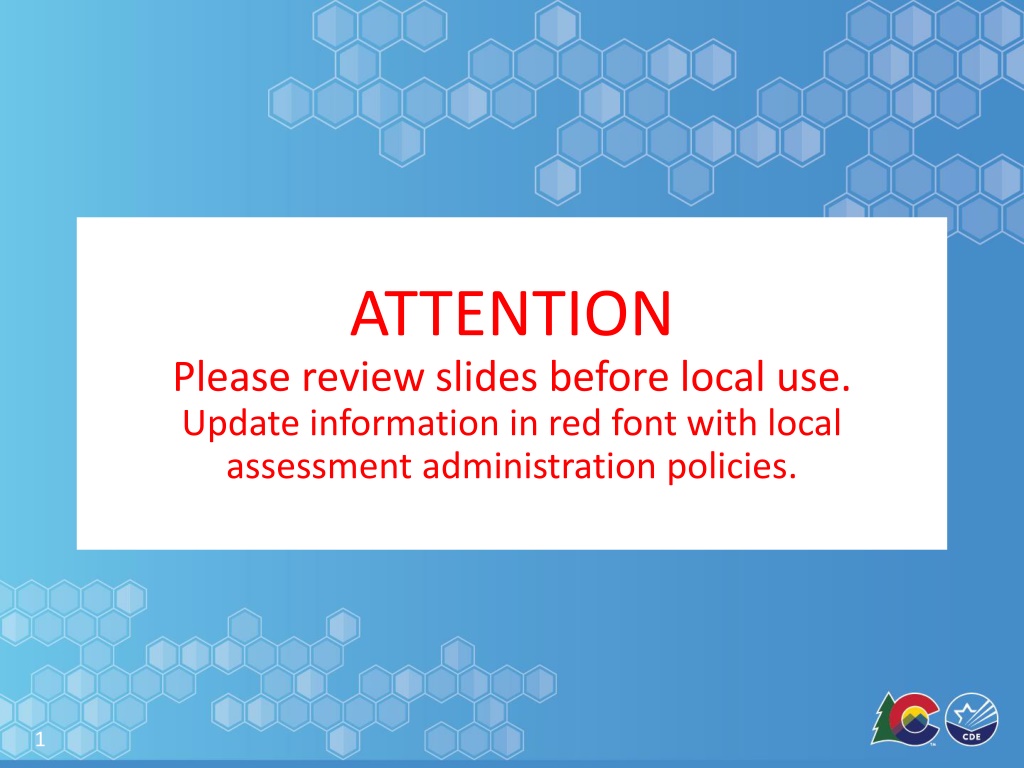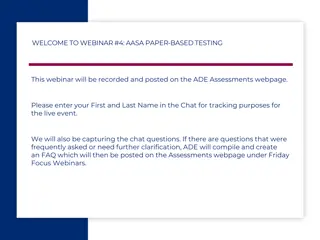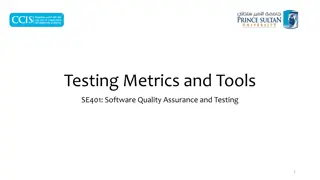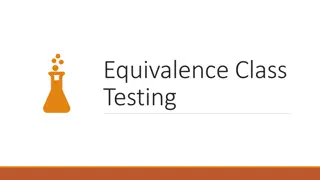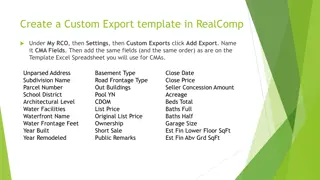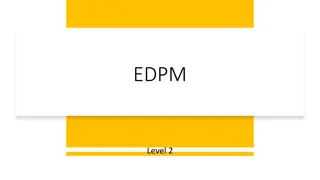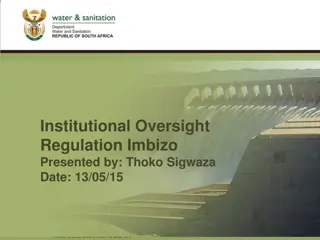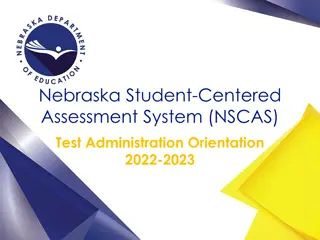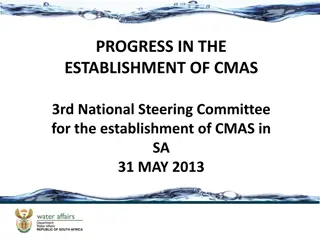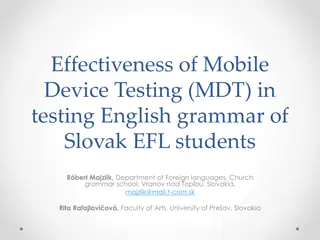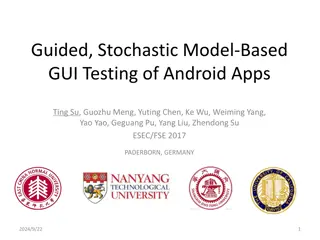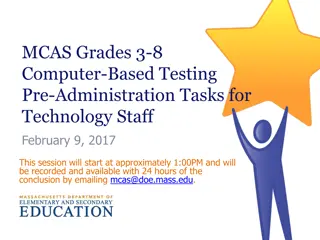CMAS Paper-Based Testing Administration Overview
The presentation covers the Colorado Measures of Academic Success (CMAS) test administration for paper-based testing in Spring 2020. Topics include testing schedule, administration policies, security measures, tasks before, during, and after testing, and required annual training for all staff involved. It also explains acronyms related to testing and provides information on the Test Administrator Manual (TAM) for maintaining security and adherence to procedures.
Download Presentation

Please find below an Image/Link to download the presentation.
The content on the website is provided AS IS for your information and personal use only. It may not be sold, licensed, or shared on other websites without obtaining consent from the author.If you encounter any issues during the download, it is possible that the publisher has removed the file from their server.
You are allowed to download the files provided on this website for personal or commercial use, subject to the condition that they are used lawfully. All files are the property of their respective owners.
The content on the website is provided AS IS for your information and personal use only. It may not be sold, licensed, or shared on other websites without obtaining consent from the author.
E N D
Presentation Transcript
ATTENTION Please review slides before local use. Update information in red font with local assessment administration policies. 1
Colorado Measures of Academic Success Test Administrator Training for Paper-based Testing Spring 2020 2
Topics CMAS Administration Overview Testing Schedule Administration Policies and Testing Security Tasks to Complete Before Testing Tasks to Complete During Testing Tasks to Complete After Testing Resources and Support 3
Annual Training Requirement Everyone involved in CMAS math, ELA, science, and social studies administration must be trained each year Includes Assessment Coordinators, Test Administrators, Test Examiners, technology personnel, and any other school or district staff involved in administration Assessment Coordinators are responsible for ensuring that all individuals involved in test administration and/or handling secure materials receive training and sign the CMAS and CoAlt Security Agreement 5
Acronyms CBT Computer-Based Testing CDE Colorado Department of Education - Assessment Unit CMAS Colorado Measures of Academic Success CoAlt Colorado Alternate CSLA Colorado Spanish Language Arts DAC District Assessment Coordinator EL English Learner ELA English Language Arts PBT Paper-Based Testing SAC School Assessment Coordinator S/SS Science and Social Studies TA Test Administrator TAM Test Administrator Manual TTS Text-to-Speech UAR Unique Accommodation Request 6
Test Administrator Manual (TAM) Information in this presentation is found in the Spring 2020 CMAS Paper-based Testing Test Administrator Manual Security measures, administration policies, and procedures identified in the TAM must be maintained Refer to checklists in TAM for before, during, and after testing tasks https://coassessments.com/manuals/ > CMAS Test Administrator Manuals and Spanish Scripts > Paper-based Testing TAM Direct Link: https://coassessments.com/resource/manuals/ CO1120452_PBTAM_20_WEBTAG.pdf 7
Spring 2020 CMAS Window Assessment Grade(s) Official State Window CMAS and CoAlt: Social Studies 41, 71 CMAS and CoAlt: Science April 6 - 24, 2020 5, 8, 11 CMAS: 3-8 Math and ELA (CSLA2) CoAlt: Aligned to CMAS: Math and ELA schedule 3-11 DLM ELA and Math 1Grades 4 and 7 Social Studies are administered on a sampling basis 2CSLA is for eligible English learners in grades 3 and 4 only 8
Social Studies Individual schools are sampled once in three years 2019-20 is Year 2 of the second social studies assessment cycle Sampling plan priorities: Reduce testing burden Avoid creating cohorts of social studies students Minimize the number of students who will test as 4th and 7th graders Provide state level results that can be compared from administration to administration See notification in Syncplicity for list of selected schools and grades 9
Overview of Whats New this Year CMAS and CoAlt resource portal: http://coassessments.com Unit Timing Tables in Test Administrator Manuals Fill in table at the beginning of each set of SAY directions Example: Math Grades 6-8 Unit Timing Guide in Appendix B Use for timing calculation assistance 10
Spring 2020 CMAS Window Insert the selected district testing window information All testing in all districts must end on or before April 24, 2020 Returning materials All scorable materials must be shipped back to Pearson with a pick up by April 29, 2020 All nonscorable materials must be shipped back to Pearson with a pick up by May 1, 2020 Districts need to create an internal return schedule to meet materials return deadlines 12
Guidelines for Administration Time Time to be Allotted for an Administration Task Prepare for testing (includes reading SAY directions script from TAM and answering student questions) 10 minutes (recommended) Distribute test materials 5 minutes (recommended) ELA/CSLA unit testing time Math unit testing time ES/MS Science/Social Studies unit testing time HS Science/Social Studies unit testing time 90-110 minutes* 65 minutes 80 minutes 50 minutes Complete end-of-unit activities, including closing units and collecting test materials 5 15 minutes (recommended) *Testing time depends on grade level refer to Unit Testing Times and Testing Multiple Groups at http://www.cde.state.co.us/assessment/cmas_utt_tmg 13
Unit Testing Times: Grades 3-5 Assessment # of Units Section Minutes Unit 1 Non-calculator 65 Math Grades 3-5 Unit 2 Non-calculator 65 Unit 3 Non-calculator 65 Unit 1 90 ELA Grades 3-5, incl. CSLA Grades 3-4 Unit 2 90 Unit 3 90 Unit 1 80 Social Studies Grade 4 Unit 2 80 Unit 3 80 Unit 1 80 Science Grade 5 Unit 2 80 Unit 3 80 14
Unit Testing Times: Grades 6-8 Assessment # of Units Section Minutes Unit 1 110 ELA Grades 6-8 Unit 2 110 Unit 3 110 Unit 1 80 Social Studies Grade 7 Unit 2 80 Unit 3 80 Unit 1 80 Science Grade 8 Unit 2 80 Unit 3 80 15
Unit Testing Times: Grades 6-8 Math Assessment # of Units Section Minutes Non-calculator Unit 1 65 Calculator Math Grades 6-8 Unit 2 Calculator 65 Unit 3 Calculator 65 Refer to the Calculator Policy at http://www.cde.state.co.us/assessment/cmas_calculator_policy 16
Unit Testing Times: Grade 11 Assessment # of Units Section Minutes Unit 1 50 High School Science Unit 2 50 Unit 3 50 17
Guidelines for Administration Time Add the unit testing time to the start time to determine the stop time Triple check this! Miscalculation of unit testing time will result in misadministration and invalidation or suppression of student test scores Provide the entire amount of unit testing time Once the unit testing time is met, the unit must end A student may only be allowed an extended time accommodation if listed in his or her IEP, 504, or EL Plan If all students complete testing before the unit testing time is met, the unit may be ended (no minimum testing time) Test Administrators may not encourage students to finish any unit early A student may be allowed an extended time accommodation only if listed in his or her IEP, 504 Plan, or EL Plan Math and ELA: time-and-a-half is not included in unit testing time Science and social studies: time-and-a-half is included in the unit testing time 18
Administration Policies and Test Security 19
Active Administration Maintain standardization of the assessments: Ensure students have all necessary materials for each unit Ensure a standardized testing environment Follow all directions and scripts exactly as written Move throughout the room during testing Re-read and clarify TAM SAY directions (general administration directions read aloud to all students from the TAM) to students when asked Use proximity to keep students on task Use continue working script from TAM for off-task students 20
Prohibited Activities Test Administrators may not engage in activities that impact validity, reliability, or fairness of the tests: Provide feedback or coach students Clarify test questions Read passages, sources, or test questions to students* Answer content related questions Interfere with the students demonstration of skills Interact with students in any way that would impact student responses Allow students to communicate with each other in any way, or use prohibited materials Engage in other tasks during test sessions Actively read or view assessment items or content before, during, or after testing* Actively read, view, score (formally or informally), or comment on student responses* Leave test materials unsecured Discuss or disclose test content through verbal exchange, email, social media, or any form of communication Download any part of the assessments* *Except as part of specific accommodations 21
Guidelines for Breaks Between units, scheduled breaks may occur Students may not have access to cell phones during scheduled breaks Activity Time Unit 1 8:00 a.m. 10:00 a.m. Scheduled Break 10:00 a.m. 10:15 a.m. Unit 2 10:15 a.m. 12:15 p.m. During each unit, a short stand-and-stretch break is permitted at the discretion of the Test Administrator Time stops for the unit, but only for up to 3 minutes Restroom breaks during testing do not stop the clock 22
Make-Up Testing Students who are absent, become ill, or who can no longer test because of classroom or school interruptions during originally scheduled units participate in make-up testing Students are not allowed to return to any completed portion of a unit Test security and administration protocols apply All units for all content areas must be administered in sequential order, including for make-up testing NOTE: It is a misadministration to administer units out of order. 23
Guidelines for Administration After students finish each unit, individual students are to Sit quietly? Leave and go to a location outside of the testing environment? Read? (cannot use any electronic reading devices) Will there be a minimum time set for the testing environment? What are TAs to do when all students have completed a unit? School Site Considerations if releasing students to an outside location: Where will they go? To whom will students be released? 24
Guidelines for Administration Optional Text in SAY Directions Read the following script option regarding allowable activities if students finish early (Identify which of these options the district will allow) Option A Students are to sit quietly when they are done testing. Option B Students will be dismissed when they are done testing. Option C Students may read when they are done testing. 25
Administrative Considerations Changes to the conditions of testing that may benefit a student Available to any student as long as test security is not compromised and test environment requirements are met Available Administrative Considerations: Adaptive and specialized equipment or furniture Frequent breaks (do not stop the clock) Noise buffers/headphones Small group testing Specified, separate, or alternate area or seating Time of day 26
Emergency Accommodation A case where a student needs a new accommodation immediately due to unforeseen circumstances Cases could include students who have a recently-fractured limb (e.g., arm, wrist, or shoulder); whose only pair of eyeglasses have broken; or a student returning from a serious or prolonged illness or injury Contact the SAC so the Emergency Accommodation form can be completed and the appropriate steps can be taken to provide the accommodation 27
CSLA Accommodated Form Colorado Spanish Language Arts (CSLA) is a paper/pencil language arts accommodated form Available for eligible 3rd and 4th grade students who are English learners Administered in place of ELA These students take the math assessment in Spanish 4th graders at schools selected for social studies take the social studies assessment in Spanish 28
Accommodations and Accessibility Features If administering the following accessibility features or accommodations, ensure training is received this school year: Auditory Presentation (Oral Script) ELA/CSLA - unique accommodation requiring a CDE-approved UAR Follow audio guidelines English or signed presentation of ELA Spanish presentation of CSLA Math, science, and social studies English oral script Spanish oral script Oral script only for translation into a language other than English or Spanish, including signed presentation Scribe ELA constructed response unique accommodation requiring a CDE- approved UAR ELA selected response - accommodation Math, science, and social studies accommodation 29
Technology for Medical Monitoring Students who use a phone, tablet, or other device to monitor a medical condition may have the device in the testing room Documentation of medical necessity must be kept at the school and district Follow the district s plan for use of these devices: Where the device is located and who has control of the device If the student has control, the device must be visible at all times and may not be used for any other purpose Procedures for if/when the device alerts and what action is necessary If student has to leave the testing environment, follow procedures for students who become ill 30
Chain of Custody Document any movement of secure materials before, during, and after testing Sign/complete the chain-of-custody form when checking materials out/in Receive materials (e.g., scratch paper, oral script for translation, Student Testing Tickets) from SAC only on the day of testing Receive only the content area and grade level being assessed at that time At the end of the testing session, return all materials to the designated secure location Materials must not be stored in classrooms 31
Maintaining Security of the Assessments All test materials must be secured while in the Test Administrator s possession No duplication of secure materials is permissible No cell phones or other communication, reproduction or recording devices are allowed during test sessions unless required for accessibility Students should be aware that cell phones or other electronic devices are prohibited. Students who are found with electronic devices in their possession during testing (including if they have finished testing but other students have not) or during a break may lead to the invalidation of not only their test, but to the invalidation of others tests as well. All individuals are strictly prohibited from taking photos of TestNav screens and all secure test materials 32
Test Materials Security PBT Secure Non-Secure Test Administrator Manuals (TAM) Procedures Manual Unused scratch paper Math reference sheets and high school science periodic tables if not written on Paper-based test books Source books (social studies) Periodic table (high school science) Oral scripts Used scratch paper Any student work/responses (e.g., printed from AT device) Printed math reference sheets just prior to and after testing If written on during testing these cannot be reused 33
Testing Different Grades Together If the unit testing time and directions are the same, different grades can be administered in the same room A separate testing environment is needed for: PBT and CBT (administration SAY directions and materials are different) ELA and math (unit testing times and SAY directions are different) Directions read aloud in a language other than English English tests and Spanish accommodated forms Science/social studies and ELA/math (testing times and SAY directions are different) PBT science and social studies (materials and SAY directions are different) High school science/social studies and elementary/middle school science/social studies (different unit times) Math grades 3-5 and math grades 6-8 (different SAY directions) Math grades 6-8 unit 1 and math grades 6-8 units 2 and 3 (different SAY directions) http://www.cde.state.co.us/assessment/cmas_utt_tmg 34
Room Configuration Students should not be able to see each other s work from a normal testing position Consider the following seating configurations to maintain test security: Seat students in every other seat Seat students back-to-back Seat students in a semicircle Seat students in widely spaced rows or in every other row (appropriate for a classroom setup) Dividing screens or other privacy materials may be used if students cannot be placed far enough away from each other 35
Test Environment The testing environment must: Be adequately lit, quiet, free of distractions, and heated or cooled Provide an adequate writing surface for paper-based materials Test book Source book (social studies only) Periodic table (high school science only) Math reference sheet (grades 5-8 only) Scratch paper Be free of electronic devices and music Do Not Disturb/Only Authorized Personnel Allowed sign must be placed on the door during test sessions Display unit testing time for students: Unit Name: Grade 8 Science, Unit 1 Unit Testing Time: 80 Minutes Start Time: 9:00 Stop Time: 10:20 Note: Triple check unit testing time and stop time calculation 36
Test Environment Prohibited Materials All cell phones Exception: TA may have a cell phone for emergency use ONLY, but the ringer must be turned off Exception: Student medical monitoring devices Electronic devices including, but not limited to: E-readers Personal document scanners Electronic pens Smartwatches iPods, MP3 players, or other music players Instructional aids relevant to content being assessed Reference books (exception: word-to-word dictionaries for EL) No food or drinks are allowed on desks or near test materials 37
Test Environment The testing environment must be free of any content related posters or aids that may suggest possible answers to students Posters that do not include content specific definitions, content related processes, or solutions may remain on the wall Prohibited visual aids in the test environment must be removed or covered Number lines Word walls Steps for solving math equations Maps Charts Models Any content related materials Any resource that defines, explains, or illustrates terminology or concepts General Rule: When in doubt, cover it. 38
Student-to-Test Administrator Ratio Student-to-Test Administrator ratio must not exceed 30 to 1 Test Administrator must be able to actively monitor the space within the physical testing environment Consider room configuration Make special considerations for large testing environments or environments with complicated configurations Test Administrators must: Actively proctor Remain attentive and in the room during the entire testing unit Circulate throughout the room during the test Should be able to see students working, not student work 39
Unauthorized Visitors and the Media Only students, Test Administrators/Examiners, and authorized school, district, state personnel, or state-sanctioned test monitors may be in testing areas during administration Media are not allowed to have access to the tests before, during, or after test administration, or take pictures or video of testing materials or testing students Parents are not allowed in the testing room with their child 40
Security Breaches Reporting Testing Irregularities and Security Breaches: 1. All instances of testing irregularities and security breaches must be immediately reported to the SAC, and subsequently, the DAC Should a testing irregularity or security breach occur, be prepared to provide a written statement of the incident to the SAC 2. 41
Safety Threats and Severe Weather Know the Plan for Safety Threats and Severe Weather: 1. 2. 3. Note the time of the disruption and time remaining in unit Secure test materials as specified in the School Security Plan Upon return, prepare students for the continuation of the unit and resume tests Document the situation in writing (report a testing irregularity or security breach to the SAC) 4. 42
Contaminated or Damaged Materials Contaminated or damaged test materials must be replaced 1. Stop testing and record the remaining time, the item the student is on, and the page number 2. Immediately contact the SAC for next steps 43
Student Readiness Student practice resources are available on http://coassessments.com Colorado Practice Resources (CPRs) for paper-based and computer-based CPR Guides - include scoring information (e.g., answer keys and rubrics) During testing, Test Administrators cannot help students with answering questions in test books, including how responses are indicated Strongly recommend students are provided with access to practice resources prior to testing Paper-based tests include constructed response, converted technology- enhanced, and selected response items in previous administrations it was reported that some students were unsure of how to indicate answers to selected response questions 45
Accommodations and Accessibility Features To prepare for providing accommodations: Administer student practice resources to students https://coassessments.com/test-prep/ Review resources: Section 6.0 in the Spring 2020 CMAS and CoAlt Procedures Manual https://coassessments.com/resource/manuals/Section6_0.pdf CMAS Accessibility Features and Accommodations Trainings https://coassessments.com/training-mods/ Auditory presentation: oral scripts supervised early access to script for rehearsal, if applicable Confirm students with accommodations are testing in an appropriate environment 46
Test Administrator Access to Materials TA access to test materials is only available on the day of testing 1. Check materials out using school chain-of-custody form 2. Administer assessment 3. Check materials in using school chain-of-custody form There are early access exceptions for some accommodations See accommodations training information Secure test materials must: Not be removed from the school s campus Never be left unattended Be secure while in the TA s possession 47
Tasks to Complete Before Testing At least one week before testing: Review the Test Administrator Manual and attend training to understand policies and instructions for the spring 2020 test administration Sign the CMAS and CoAlt Security Agreement form Prepare to administer accommodated tests, if necessary Optional: Administer the Colorado Practice Resources (CPRs) https://coassessments.com/test-prep/ 48
Tasks to Complete Before Testing One day before testing: Prepare the testing environment Ensure the spring 2020 administration instructions (TAM) are available Know what, when, and where testing will take place Arrange for school-supplied materials (e.g., scratch paper, calculators) 49
